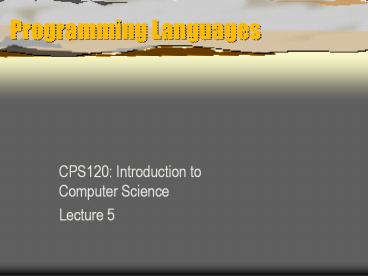Programming Languages - PowerPoint PPT Presentation
Title:
Programming Languages
Description:
Programming Languages CPS120: Introduction to Computer Science Lecture 5 – PowerPoint PPT presentation
Number of Views:165
Avg rating:3.0/5.0
Title: Programming Languages
1
Programming Languages
- CPS120 Introduction to Computer Science
- Lecture 5
2
Programming Languages
- A programming language is a set of rules that
provides a way of telling a computer what
operations to perform.
3
Levels of Programming Languages
- Machine language
- Assembly Language
- High Level Languages
- Fourth Generation Languages (4GL)
4
Machine Languages
- different for each computer processor
- 0100
- 001101 100000 001101 110001
- 00101 10001 10000
- 01110
- 111001
- . . .
5
Assembly Languages
- different for each computer processor
- main proc pay
- mov ax, dseg
- mov ax, 0b00h
- add ax, dx
- mov a1, b1
- mul b1, ax
- mov b1, 04h
6
High-Level Languages
- Higher Level Languages
- Use traditional programming logic where the
programming instructions tell the computer what
to do and how to perform the required operations. - 4GLs
- Use high-level English-like instructions to
specify what to do, not how to do it .
7
Interpreter vs. Compiler
- Interpreter
- Translates instructions to machine code
line-by-line. - Compiler
- Translates the entire program to machine code
before running it.
8
Types of Programming Languages
- Machine language
- Procedure-oriented languages
- Object-oriented languages
- Event-driven languages
9
Early Language History
- FORTRAN (short for Formula Translator, developed
in the 1950s by IBM - In 1958, a language called ALGOL (Algorithm
Language) was developed - COBOL (Common Business Oriented Language) was
created in 1960 to serve as the primary language
for large-scale programs - In 1964, the BASIC language (Beginners
All-Purpose Symbolic Instruction Code) was first
used - In 1965, a language called PL/I was developed in
hopes of being everything to everyone. - PL/I proved to be too complex.
- In the late 1960s, Niklaus Wirth developed a
teaching language called Pascal.
10
Later Language History
- Ada, which was developed in 1983, is large and
complex. - Smalltalk is graphical and object-oriented.
Concepts developed with Smalltalk were important
to the development and continued development of
languages like C and Java - The C language was derived from ALGOL.
- C is C with the addition of object-oriented
concepts.
11
Procedure-Oriented Languages
- FORTRAN
- COBOL
- Pascal
- C
- Ada
12
OOED Languages
- Object-oriented languages
- Smalltalk
- C
- Ada 95
- Event-driven languages
- Visual Basic
- most Visual languages
13
What Can a Program Do?
- A program can only instruct a computer to
- Read Input
- Sequence
- Calculate
- Store data
- Compare and branch
- Iterate or Loop
- Write Output
14
Fundamental Programming Concepts
- Assignment of values to a variable
- Iteration (Looping)
- Over a set of set of statements
- With respect to a logical expressions
(conditions) - Delegation of sub-tasks to functions / procedures
15
The Structure Theorem
- The Structure Theorem states that any algorithm
can be built from three basic control structures.
- One-after-another (Sequence)
- Decision-making (Selection)
- Making choices between 2 or more alternatives
- Repetition (Iteration)
- Concerned with repetitive tasks (and the
termination conditions of loops)
16
C Control Structures
- "Sequence statements" are imperatives
- "Selection" is the "if then else" statement
- AND, OR, NOT and parentheses ( ) can be used for
compound conditions - "Iteration" is satisfied by a number of
statements - "while"
- " do "
- "for"
- The case-type statement is satisfied by the
"switch" statement. - CASE statements are used for most non-trivial
selection decisions
17
Programmer Productivity Tools
- Modular Programming
- Structured Programming
- Object-oriented Programming
18
Modular Programming
- Large programs are divided by functional parts
into subroutines - Strong cohesion
- Loose coupling
19
Structured Programming
- Composed of sequence, decision (selection), and
repetition (looping or iteration) structures - Structured program languages lend themselves to
flowcharts, structure charts, and pseudocode. - Structured programming languages work best where
the instructions have been broken up into small,
manageable parts. - Looks at a problem as procedures
- Data are maintained separately from data
20
Structured Program Rules
- Use only sequence, decision, and repetition
- Only one entrance into and one exit from a
structure - Connectors only allowed when continuing
processing from one column or page to another - Decision and repetition structures can be nested
- Only one STOP instruction is permitted. It must
be in the MAINLINE routine
21
Structured Programming Advantages
- Standard method for solving problems
- GO-TO less
- Easier to test and debug
- Written by more than one programmer
- Reusability
- Thrashing minimized
22
Object-Oriented Programs
- Developed to respond to programming issues that
structured programming did not adequately address - Rarely possible to anticipate the design of a
completed system before implementation - GUIs were difficult to develop in traditional
procedure-oriented languages - Sharing data across routines is error prone
- Information hiding allows programmers to
determine what data is exposed to various
routines































